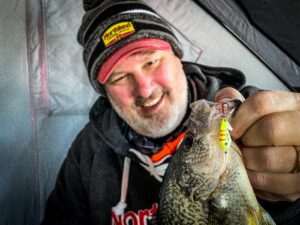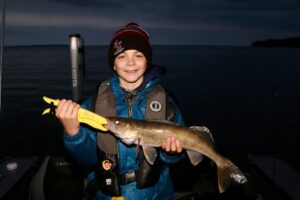
The Finest Four Weeks
- By The Fishing Wire
From now through early June is arguably the best stretch to score walleyes on northern natural lakes
By Jim Edlund
Muskegon, MI – Spring is here – and with it, great Walleye Belt opportunities to put the smackdown on marble-eyes, which are more easily caught during this period than throughout much of the remaining seasons.
While walleye season openers vary from state to state (some states remain open year ‘round), early-season walleye behavior is similar wherever you fish, following their annual spawning rite that occurs when water temperatures are between 42- and 50-degrees accompanied by the right length of day and night (photoperiod).
First, following the spawn, male walleyes will stay in relative proximity to shallow spawning sites up to the first major breakline for up to a month, feeding opportunistically. Contrary to belief, they are not guarding the spawn site; neither male nor female accompany the biological mass after the spawning process. After quickly depositing their eggs, female walleyes vacate to recuperate in nearby, deeper water, a process that can take days to weeks, only feeding when the meal is easy.

However, combine something like a simultaneous spot-tail shiner spawn in the same locations and you’ll find a mix of both smaller males and good-sized females ready to feed after the metabolic drain of the spawn. Match the hatch? You bet. In many places (like Minnesota) the most popular live bait for early-season walleyes are spot-tail shiners presented on jigs. They aren’t cheap, but can literally be worth their weight in gold. Of course, you can also trap/seine your own to save money, but make sure you pay attention to AIS and legal restrictions before doing so, especially when it comes to transporting your own trapped bait.
What makes for a good spawning site?
A good walleye spawn site typically comprises gravel substrate that the eggs easily cling to and provide the space for current or wind action to fertilize the eggs once the males deposit their milt. Rivers, streams, and creeks attached to main lakes are all good walleye spawn locations (and the areas surrounding), as are windswept shores, banks, and points or reefs on lakes lacking tributaries in and out that walleyes can utilize.

Location
Focus on the aforementioned areas whether you’re in waders, on the bank, or in a boat. Gravel shorelines are a no-brainer and farther out, emerging weed beds in 3-12 feet of water are often gangbusters with post-spawn walleyes. Windblown shorelines, too, can be key, where wind stirs up the bottom, attracts baitfish, and brings in hungry fish. Especially as weeks progress following the spawn, start fishing a bit deeper on the sand flats, targeting both sides of the first break or any bottom transition areas of sand to rock or mud to gravel.
Presentations
Given predominant post-spawn water temps under 55-degrees, slower presentations often work best. A simple jig and minnow is a mainstay – especially with a spot-tail shiner – but you can also catch fish on other types of minnows or a soft plastic fluke or paddle tail, as well as classic hair jigs. Just don’t overwork your presentation, carefully making bottom contact and hopping or twitching the bait with a slow cadence. Given depths under 10-feet for much of the period, 1/8- to 1/4-ounce jigs are most often used. A lot of anglers prefer longer shank jigs with a bait keeper for hooking and keeping expensive shiners pinned.
Although jig and meat or plastic get the most play, don’t overlook stickbaits like X-Raps, original floating minnow Rapala, Mad Scientist Tackle Predator Jerkbaits, Husky Jerks or Storm Thundersticks – actually, anything with a long, minnow profile. Especially fished in lowlight or at night, walleyes will crush minnow-shaped crankbaits, which emulate what they’re eating – typically spawning spot-tail shiners or young-of-the-year perch.

Power Hours & Technology
While you can catch post-spawn fish during calm and sunny conditions, you’ll need to keep your distance to prevent spooking them. In clear waters, fish can often be spotted via polarized sunglasses, but that usually means you’re too close. This is where technology comes in.
Sure, you can use forward-facing sonar, but with walleyes hugging bottom in most of these shallow areas, you’ll want to switch your transducer to landscape mode rather than forward.
Side Imaging is really the ticket when locating walleyes on large shallow flats. Look for smaller pods of fish between a couple and a dozen and they’ll most likely be walleyes. Drop a waypoint, creep up with your trolling motor on low, and start casting from as far away as possible. If you spot larger schools of fish, say, 20-50 fish in groups, chances are you’re looking at suckers and it’s best to move on and keep covering water.
To further optimize your time on the water, fish early morning, evening, night, and during windy/overcast conditions. And given these conditions, don’t be afraid to fish really shallow – as in right near shore up to about four feet. If there’s one thing anglers have learned over past decades, it’s that there are a lot more walleyes up shallow than we ever thought. With natural lakes coming alive with weed growth, all kinds of biological matter stirred up by wind, and the presence of baitfish – if the minnows are in skinny water during this time, the walleyes will be, too.

The Right Stuff
When picking out a rod and reel from the garage for early-season walleyes, it’s best to keep things on the light side. A medium-light power, fast or extra-fast action, 6’8” to 7’2” rod is perfect, typically paired with a 2500 or 3000 size reel for long casts.
I’m a big fan of the budget-friendly DAIWA TD Eye paired with a 2500-size DAIWA TATULA MQ LT spooled with 10-pound braid and a 10-pound fluorocarbon leader. If fish are super shallow, I’ll carry the same rod with a 1000 size TATULA spooled with 6-pound monofilament and tie my jig direct, the buoyancy of mono providing some extra loft to 1/16- or 1/8-ounce jigs in such skinny water.
Take Home
The bounty of shallow, early-season walleyes in natural lakes doesn’t last long – about a month after the spawn, so best get while the getting’s good. Following this period, you’ll notice fish on or past that first breakline, and fish behavior and subsequent presentations need to be changed. So, have fun during the month of May, keeping mind of lake-to-lake slot limits, regulations, and walleye year class densities to determine what you keep for the fryer.

SPRING WALLEYE GEAR from WHITEWATER

NEW Riparian Jacket FEATURES:
The Riparian™ Jacket is a hardworking, two-layer rain jacket built for ultimate weather protection. Constructed from tough mini-ripstop stretch nylon with a smooth polyester lining, it’s designed for durability and easy on-and-off wear. A dual storm flap design, combined with a waterproof, windproof laminate, and fully taped seams, forms an impenetrable barrier against the elements. The three-piece hood features multiple adjustment points for a customized fit, while hook-and-loop cuff closures help lock out rain. Strategically placed reflective tape ensures visibility in low-light conditions. AquaGuard® zippered handwarmer pockets keep your hands dry, while two chest and two waist pockets offer ample storage for gear. A heavy-duty D-ring provides a secure attachment point for your safety kill switch cord, making the Riparian™ Jacket a reliable companion for any storm.
MSRP $269.99

NEW Riparian Bib FEATURES:
The Riparian™ Bib features adjustable suspenders with a silicone grip-enhanced design and low-profile buckles ensure a secure fit, so you can focus on the catch not your gear slipping. Constructed from durable mini-ripstop stretch nylon with a smooth polyester lining, these bibs offer flexibility and comfort, while leg zippers make them easy to slip on and off. A dual storm flap design on the main front center zip, along with a waterproof laminate, fully taped seams, and zipper storm flaps, creates an impenetrable barrier against wind and rain. AquaGuard® zippered handwarmer pockets provide a dry refuge for cold fingers or a secure place to store your belongings. Multiple reflective tape placements on the back and chest enhance visibility from all angles. Two spacious cargo pockets on the legs provide ample storage for essentials such as your phone, keys, or an extra pair of gloves, ensuring everything you need is within easy reach. The two Velcro waist adjustments allow you to dial in the fit for maximum comfort and secure wear throughout the day.
MSRP $269.99
About Whitewater
Whitewater performance fishing apparel gives anglers distinct advantages whenever Mother Nature’s unpredictability conspires to ruin angling adventures. Whether faced with wind, rain, snow, sun, or extreme temperatures, Whitewater apparel equips anglers with the ability and confidence to overcome the elements, so they apply their focus and energies on fighting fish, not the conditions. Whitewater is a brand by Nexus Outdoors, headquartered in Muskegon, Michigan, USA. Learn more and order at whitewaterfish.com.












